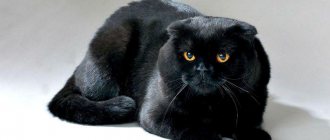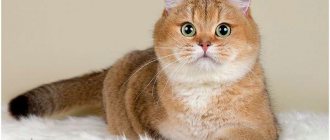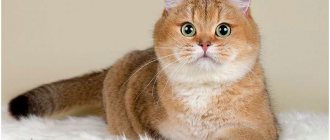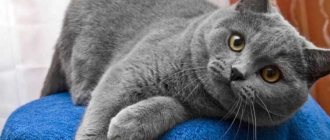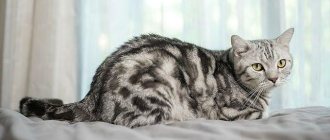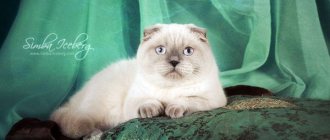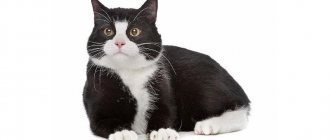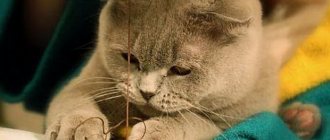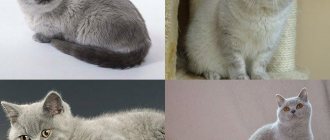Features and types of color
The natural British cat has a blue or ash-colored coat.
To obtain other varieties, scientists crossed representatives of this breed with other cats of similar type, for example, with exotics. All British cats that are lucky enough to have a pattern on their fur are united by the name “Tabby”. Colors of this type can be ticked, spotted, striped.
Main list of other tabby colors:
- ticked - in appearance it seems that this look is more like a solid color, but if you move the fur apart, you can see that each hair has a striped pattern. Of all the breed standards for this coat color, the so-called tabby cats, only cats of this species should not have the letter M on their forehead;
- spotted - the most common pattern; eyes can be copper or emerald;
- tiger stripes (mackerel) - the stripes on the coat must be thin and clear, large stripes are rejected by experts. Eye color can be green (emerald) and copper (light yellow, dark);
- marble is the most complex and bizarre pattern, only in this type of color the contrast is not rejected. There should be designs in the form of a necklace on the chest, rings on the tail and on the paws. Moreover, this is the only type of pattern where the pattern cannot be interrupted or intersect.
The British merle also comes in a variety of patterns and colors: chocolate, tortoiseshell, merle on gold (red), blue silver merle, lilac silver (very rare). The golden marbled shade is often obtained by cats that have green eyes, which looks very attractive.
The color standard is expressed in a clear alternation of coat color; the following elements must be present:
- the letter M on the forehead (a mark on the forehead in the form of the letter M, which must have the color of the coat of the pattern, and not the main one);
- alternating stripes on the legs and rings on the tail;
- contrasting pattern on the back and sides, dark eyeliner and nose;
- on the shoulders there is a pattern very similar to a butterfly.
Only cats can have three colors in their fur; they can even have red fur; healthy British merle cats are always two-colored. If a cat was born with three coat colors, then he is infertile.
Description: what does the standard look like?
Variety of colors
The most famous color is black marble on silver, where the main tone is white-silver with a clear black pattern. In addition, cats of the British breed have the following colors:
- Gold marble (black marble on gold). There is a black and brownish pattern on a golden brown background.
- Chocolate marble. There are clear brown stripes against the café au lait background. The chocolate shade has varieties of silver (light base color and brownish pattern) and golden, where yellowish predominates in the shades.
- Blue marble. Includes a combination of dark and light gray.
- Red marble. This is a bright red cat with a characteristic pattern of a darker tone.
- Red silver marbled cats. They are distinguished by a light base color and light brown stripes.
Return to contents
Breed standard
The British marbled cat breed cannot have fold ears, so kinks in the ears are considered a deviation. Disadvantages include an incorrect bite, a narrow muzzle, a hump on the nose or a sign of brachycephalic breeds, and a pronounced pinch. Marbled kittens must be tabby, any baby from the litter must have short hair. The basic requirements for the breed are shown in the table:
| Body part | Characteristic |
| Body | Medium size, proportional, muscular |
| The chest is developed, the shoulders are wide, the back is straight | |
| Weight up to 8 kg | |
| Head | Rounded, cheeks pronounced |
| The nose is straight, the nose is large | |
| The transition from the forehead to the muzzle is pronounced, but not too obvious | |
| Ears | Small, pyramidal, widely spaced, rounded tips |
| Eyes | Round, wide open |
| Marble cats have a main shade of honey-yellow; cats with blue eyes come only in point color | |
| Paws | Thick, powerful, straight, rounded pads |
| Tail | Medium, thick, tapering to the tip |
| Wool | Short, loose fitting, thick |
| Undercoat present |
Return to contents
Character
Cats of the British breed have a calm disposition, this is a truly English character: restraint, aristocracy, delicacy and unobtrusiveness. They are devoted to their owner, despite their independence, and love to stay at home. As a rule, these cats do not run away from home and do not appear in lost ads.
Marbled British do not show aggression even if something is done against their will. Many representatives of this breed are very playful and spontaneous, so they will need household equipment and toys to keep them. They do not like strangers, they rarely go into the arms of anyone except their family.
Communication and perception
Like domestic cats, marbled cats can purr and meow, however their "meow" is described as a chirping sound instead of a more continuous sound. They rely heavily on their vision to see in low light conditions. Their shorter and more rounded skull with flattened nasal bones gives them a more spacious view. This morphology, combined with large amber eyes with vertically oriented elliptical pupils, provides the maximum vision needed for locomotion in low light conditions.
Breeding marbled kittens
The British marbled kitten is considered one of the most recessive species. Therefore, if the goal is to obtain just such a color, you should not allow an animal that has a single-color coat to be mated. Most likely he will defeat the marble gene.
To breed merle-colored cats, it is necessary to select for mating both participants with the required data: a pattern on the forehead in the form of the letter M, dark eyeliner and nose, rings on the tail, light spots on the back of the ears.
The most popular British kittens today are black marbled on silver.
Where did the British come from?
The first ancestors from which the marbled Britons descended were brought to the territory of the British Isles from Rome and Egypt. The cats were distinguished by their powerful physique and high hunting instinct. The locals liked this because the cats began to destroy rodents that were spoiling the harvest. People and animals got along well, as cats had a proud disposition and unpretentiousness. For several centuries no one studied the breed. In 1889, an exhibition was held in London where the British white cat was presented. Real interest arose only in the 20-30s of the twentieth century, when, according to a program specially created by felinologists, they began crossing animals and breeding the breed. In 1980, the breed was recognized by the International Federation of Cat Fanciers. The marbled cat was bred through selection.
Recommendations for care and maintenance
Caring for British merle cats and cats is not that difficult, but it will take time.
It is recommended to comb animals with a special comb several times a week. This is done to prevent the wool from matting and matting. It is best to bathe Britons when their fur gets dirty. Usually 1-2 times a year, sometimes they are bathed immediately before exhibitions. For bathing, you should use special shampoos, not the ones that people use. Nails are trimmed every 2-4 weeks as they grow. For this procedure, you should use a special nail clipper. Animals' ears should be cleaned very carefully and only when dirty. To do this, it is recommended to use a special liquid and a cotton pad; do not clean cats’ ears with cotton swabs. You should also take very careful care of your eyes. They can only be wiped with a cotton pad or a piece of gauze soaked in warm water or chamomile infusion.
If pus is detected in the eyes, it is very important to promptly seek veterinary help and not self-medicate.
Before vaccinations, animals are always given a remedy for helminitis. It can be either a suspension or a tablet. The main thing is to give the medicine according to the instructions and the weight of the animal.
A cat must have its own place in the house. It can be either a cat house or a small pillow for sleeping. It is advisable to have scratching posts, otherwise animals may involuntarily scratch floor surfaces and furniture.
As for feeding animals, they can be fed food or natural. Both diets have their pros and cons. The main thing is that any diet is balanced. Ready-made food is already such, but if we are talking about natural food, then in no case should it consist of food that a person consumes. Anything spicy, fried or salty, as well as fish and chicken bones are contraindicated.
The British are recommended boiled vegetables, lean meat (idea, rabbit, chicken, young sheep), cottage cheese, yolks and some fermented milk products without additives
Whatever diet the animals are on, it is very important that they always have clean and fresh water. Bowls should always be washed thoroughly after eating
Caring for the British Marbled's coat
By nature, these cats are clean, they take good care of their fur, actively licking themselves, but to make the fur look perfect, human intervention is essential:
- Grooming is trusted to professionals; without proper experience, it is easy to ruin the appearance of your pet. This breed sheds profusely; grooming will significantly reduce the amount of hair in the house. In the summer, the procedure helps cats not suffer from overheating. The British should not be given sedatives before visiting the hairdresser, but due to their phlegmatic nature, they rarely show resistance.
- To comb, you need to purchase a rubber slicker brush or a comb with rounded teeth. Domesticated individuals shed longer and more heavily than their walking counterparts. You need to scratch your cat every day.
- It is not necessary to bathe this breed often; 2 times a year is enough. Water for bath procedures should be warm, about 30°C, washing products are selected taking into account color. Show cats are bathed more often, up to once every 1-2 months.
Be sure to read:
What food should you feed your adult Scottish Fold cat and kitten?
To prevent the appearance of fleas, preventive disinfestation should be carried out (the regularity depends on the duration of the drug specified in the instructions), and special insect-repellent collars should be put on the animal.
Breeds of cats with merle color
Kurilian Bobtail
This color is found in many breeds:
- British and Scottish, differing only in the shape of the ears. For a Briton they are normal, for a Scot they are bent forward and hang down. The British have the greatest difficulty in breeding the marbled tabby due to the moire factor.
- Asian tabby.
- Bengal.
- Various types of bobtails.
- American Curl.
- Bramble. This breed appeared only in 2000 and is registered only in the Register of Rare and Exotic Breeds (REFR).
- Bohemian Rex and Devon Rex.
- Napoleon.
- Maine Coon.
- California radiant.
- Munchkin.
- Oriental.
- Cymric.
- Manx.
- European and Brazilian Shorthair.
Color point color
A characteristic feature of this group of colors is a light body color and contrasting dark areas - the muzzle, ears, paws and tail.
Color point colors can be solid, tortoiseshell, smoky, shaded, veiled.
The color with black spots is called Seal point (Siamese color) .
Photo of a British kitten chocolate color point
The picture shows a British cat cream point
Each name refers to the color of the dark markings.
Colorpoints have blue or light blue eyes.
Where does the British marbled cat come from?
Since the beginning of the 20th century. British cats included not only plain blue animals, but also tabby cats with different shades on their fur coats. Thus, in 1901, American felinologists registered a Belle cat with a red tabby color.
British marbled cats appeared as a result of crossing with other breeds
The consequence of two world wars was the almost complete extermination of the British breed, so breeders began to crossbreed pets with representatives of other varieties - Burmese, Russian Blues, Persians and Scottish. The result was the appearance of many varieties of British color while simultaneously preserving the breed characteristics (wide paws, protruding cheekbones, “plush” coat).
At the same time, among all the variations of the striped coat of the British fur coat, it is the marble color that is considered classic, occurring naturally. Zoologists are inclined to believe that the symmetrical darkening on the fur of catfish from Foggy Albion is an inheritance from wild Asian or African ancestors.
British among cats
This breed is popular due to its independent and patient disposition, because British women will never get bored in the absence of their owner. At the same time, plush purrs are not devoid of a sense of tact and show full love to those who take care of them and treat them with tasty treats.
British cats are the embodiment of calm and intelligence
The British are distinguished by high intelligence - by changing the “notes” in the breadwinner’s voice, the cat will understand that it is doing something wrong. However, these little cats cannot be called too mischievous or vindictive - calmness is their strong point. At the same time, British cats are not inclined to become toys in children's hands; with excessive attention from children, the cat will prefer to run away.
Externally, British catfish differ in the following parameters:
- thick coat with dense undercoat;
- round, close-set eyes of amber color;
- massive head on a short neck;
- wide cheekbones;
- small nose with a wide bridge;
- ears widened at the base with rounded tips;
- muscular body on wide, strong legs;
- medium-length tail, rounded at the end.
Character traits
British cats are very affectionate and friendly creatures. They are quite sociable, communication skills are their strong point. This cat gets along very easily with everyone with whom she has to live in the same space. A British woman can follow a person until he gives her the opportunity to sit next to her comfortably. British cats love children very much, which is an important factor. They get along quite easily with other animals, including dogs.
The British cat has an independent character, the coat does not require special care, the animal copes with its coat itself. This animal is very suitable for those people who spend most of their time at work. They are also called “businessman’s cat.” A cat is very similar to a plush toy, but it should not be treated like a toy. The animal will patiently do everything that does not humiliate its advantages given by nature.
A British cat must be handled carefully and calmly. The British cat does not require careful training; she is smart enough to figure out everything she needs on her own. Even at a young age, a kitten will never relieve itself where it is not supposed to, and will not sharpen its claws on luxurious furniture. A small disadvantage of this breed is that the animal does not really like to sit in your arms, and may become indignant if you try to forcefully pick up the cat.
But if you have a great desire, and most importantly, the opportunity, it is definitely worth adopting this breed. A huge selection of animal colors will suit the taste of any person. They do not require special care and will make an excellent friend and pet.
But there are also many disadvantages of this breed, which can serve as a decisive factor when choosing. Cats, no matter what, are hunters, so it is necessary to provide the opportunity to realize this instinct. It will be necessary to additionally purchase appropriate play complexes for the animal, which are sold in specialized stores.
See the video below about the character of British cats.
Bicolor colors
The group includes combinations of white and other colors.
Bicolor colors are divided into 3 groups depending on the proportions of the colors.
- Van is an almost white animal, only the tail or spots on the head are colored.
- Harlequin - white makes up approximately 4/5 of the surface of the body, and there are large colored markings on the back and head.
- Bicolor - about half of the body is painted white.
The picture shows a British cat chocolate-red bicolor
British bicolors must have white muzzle, collar, hips and paw pads.
Their eyes are copper or golden in color.
The Difficulties of Breeding British Marbleds
During pregnancy, which lasts 63 days, the cat should be fed well, but not allowed to overeat. Excess weight puts extra strain on the heart. Females usually give birth on their own. It is advisable for an inexperienced owner to agree in advance with the veterinarian about the possibility of a home visit in the event of an unforeseen complication.
Often, when crossing British cats, kittens are born that breeders, out of ignorance or for profit, sell as marbled, although in fact they are moire. It is easy to distinguish one from another. Tabbies are patterned in a color different from the main one, and moire specimens are painted in a darker shade of the “base”; over time they will become monochromatic.
How to get marbled kittens
A recessive gene is responsible for this color, so to get tabby kittens it is necessary to mate parents with the same coat.
A merle litter can be obtained from the mating of a spotted individual with a brindle, two brindles, or a pair of spotted ones if they both carry the recessive gene.
Health status
The Fold cat has many genetic diseases, which are not observed in the British marble cat. Such cats live up to 20 years, have strong immunity, and rarely get sick. However, they catch cold quickly if left in the cold or draft. As well as marbled, blue, black and white British kittens and adults may suffer from the following diseases:
Animals have a strong immune system, but can suffer from diseases such as obesity.
- Obesity. Representatives of the breed are lazy and sedentary, which contributes to excess weight. This negatively affects the cardiovascular system and joints.
- Cardiomyopathy. Characterized by thickening of the heart muscle and poor circulation.
- Hemophilia. This is a bleeding disorder that can cause prolonged bleeding and lead to anemia.
- Polycystic kidney disease. Cysts form on the organs, gradually replacing the parenchyma, which leads to dysfunction.
- Tartar. The merle shorthair is prone to plaque formation on the teeth, which is dangerous for the development of gingivitis and periodontal disease.
Return to contents
Where did this color come from and why is it called that?
The question of where cats of such bizarre colors and different breeds come from will certainly arise if a British kitten appears in the house. The tabby color was most likely inherited by domestic cats from their wild ancestors, the Nubian Dun. It is from this species of cat that all our short-haired pets originated.
As for the term “tabby” itself, there are several versions about its origin. The most beautiful sounds like this. Somewhere at the beginning of the 17th century, silk fabrics, which were worth their weight in gold, were first brought to England. Their pattern was very similar to a cat's color and was called "tabbis". And when they later began to breed cats with a similar color, they were called tabby. In addition, cats of this color, like silk, were very expensive, since breeding them is extremely difficult - it is difficult to obtain the necessary pattern, shade and eye color that matches them.
How the color of the Briton was formed
There are several versions of the origin of the breed - one says that the ancient Romans brought cats from the Egyptian desert in the 1st-2nd centuries. ad. According to another legend, British cats originate from the purring Chartreuse breed, taken by medieval crusaders from the shores of South Africa.
Chartreuse cats are considered possible ancestors of the British breed
The first true Britons who settled Foggy Albion had gray-blue “stuffed” fur. This is how they were depicted in religious treatises (for example, in the Lindisfarne Gospel), poems and bestiaries. Zoologists began selection, which fixed the color, only in the 19th century, at which time the first breed standard was drawn up.
Color is the color scheme and patterns on a cat's fur coat that are formed as a result of the interaction of genetic materials responsible for the production of melanin in the body. The desired shade of coat is obtained by crossing animals with dominant and recessive genes responsible for the pattern and depth of tone. So, in British dogs with blue hair, the set of genes looks like BBdd (where B is the dominant gene that forms the black color, and d is the recessive gene responsible for muted, diluted shades). Marbled cats carry the Tb gene (where T is the dominant tabby color gene, and b is a recessive gene that makes the coat brownish, not black).
Felinologists became concerned with professionally establishing breed characteristics (including color) in British cats only after the Second World War, when the question arose of preserving this variety of domestic purrs:
- 1950 - official recognition of the British Blue breed;
- 1967 - British blue cats received the champion title from the ACA association;
- 1977 - ban on mating with other breeds, including Chartreuse;
- 1980 - recognition of the breed by the CFA Association.
Tabby cat breeds
Now we list the most popular tabby cat breeds:
- Abyssinian cat
– The most common of the Abyssinian colors is the wild, ticked tabby. The fur looks red-brown, but each hair is colored in several shades at once - from light red to brown and black, which gives the impression that the color shimmers with light-dark shades of brown. From the patterns, stripes in the form of “M” and darkening at the tip of the tail are noticeable;
- British tabby cat
– the most common coat color of pets of this breed is blue, but there are other colors, for example, tortoiseshell, rare black, white, lilac and fawn. Among the British there are also individuals with tabby and tabby point colors;
- Scottish tabby cats
(Scottish folds and Scottish straights) - such pets with hanging and straight ears can be solid solid (black, red, white, etc.), smoky and colors combined with white spots. But straight-eared and fold-eared cats with patterns on their fur, for example, silver, blue or brown tabbies, look especially impressive;
- Siberian tabby cat
– this beauty, who is our compatriot, can also be tabby in color. The luxurious striped color looks especially beautiful on the thick, semi-long coat of Siberian cats;
- Persian tabby cat
– fluffy Persians come in different colors, including their coats and tabby patterns. It’s just that it’s not always possible to clearly see marble stains or tiger stripes on such a long and thick coat. However, the characteristic letter “M” on the forehead and the rings on the tail are almost always clearly visible;
- Pixie-bob tabby
- It’s funny, but these popular cats today with short tails and tufts on their ears, first bred in Canada, are mistaken by some people for ordinary outbred animals that have lost part of their tail after getting into trouble. The color of pixie-bob cats is chocolate or gray-gray of varying saturation with the obligatory tabby markings;
- Kurilian Bobtail Tabby
- a young Russian breed bred in the 90s of the 20th century. The color of such cats can be decorated with tabby patterns, but provided that the main coat color is not fawn, lilac, chocolate or cinnamon. But black, red (red), cream, blue, silver, tortoiseshell tabby (possibly with white spots) are not prohibited by the breed standard;
- Thai tabby cat
– it is more correct to talk about the color of animals of this breed “Thai tabby point cat”. These pets have the main part of their fur white, and the ears, tip of the muzzle, paws and tail are colored brown, blue, red or cream. In addition, Thai tabbies have characteristic markings on their bodies (for example, tiger stripes or small circles on the body, the letter “M” on the head, rings on the tail, etc.). It is noteworthy that Thai kittens are born white, and only then point spots of a different color and characteristic tabby markings appear on their coats;
- Singapore tabby cat
– in color, miniature Singapuras are a little similar to Abyssinian cats, only their fur is light cream, with brown shading on the face, back and tip of the tail. The eyes and miniature nose of these pets appear circled. Each coat of Singapore ticked tabbies is colored in several shades at the same time - from almost white to chocolate brown. It is noteworthy that all Singapore cats are the same color;
- Asian tabby cat
– we are talking about Bengal, Sumatran cats and fishing cats – wild animals living in Asian countries. Sometimes they are kept as pets, but by nature they are free animals. Their fur coats also show distinct tabby patterns, which are not used as decoration at all, but for camouflage during hunting.
Tortoiseshell colors
Spots of two colors are evenly distributed throughout the body.
The colors are distributed equally and look harmonious. The thick coat is short and soft.
The paw pads are pink or black, and the eyes are copper and gold shades. Cream slippers on the paws or short stripes on the nose are possible.
British cat lilac-cream tortoiseshell
Photo of a British black tortoiseshell cat
Other photos of British tortoiseshell cats
Silver colors
In representatives of this group, each fur is not entirely colored , but only partially.
Depending on what proportion of the hair is dyed, colors are divided into 2 groups .
The first includes smoky, the second - shaded colors and silver chinchilla.
One-third of the hair is colored with the main color
Smoky cats have short, coarse, dense fur and large, round eyes that are orange and gold in color.
- Shaded and chinchilla (tipped) colors
In the British with a shaded color, the hairs are covered with the main color by one sixth, and in Chinchillas - by one eighth.
Representatives of these colors should not have patterns in the form of closed lines on the paws, tail and chest.
British Chinchillas have bright green eyes, while Shaded have yellow or orange eyes.
One way or another, it doesn’t matter whether your cat is pure black or gray-brown-crimson, for you he will be the best and certainly special.
The main thing is to learn more about short-haired or long-haired (“taste and color”) British cats, choose the right kitten, distinguishing it from a Scottish one, choose a nickname, raise it correctly and care for it, not forgetting about vaccinations for British kittens. The result will not be long in coming: you will fall in love with the British man, no matter what he looks like.

